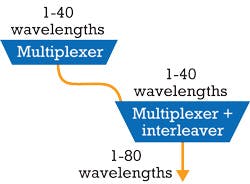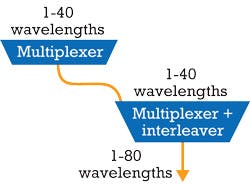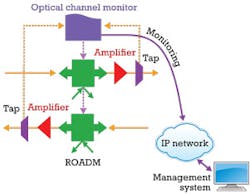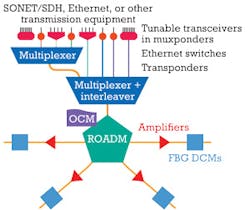The challenges of migrating to high-capacity DWDM systems
By John Spencer, P.E.
Surging demand from IP traffic, cell backhaul, and video applications has placed severe strains on fiber routes. For example, a cell site with three or four wireless providers that in the past only needed a few DS-1s per wireless provider now may require bandwidth of 300 Mbps to 1 Gbps per wireless provider. Compounding this problem is the aggregate demand from 30 to 50 cell sites on a network that may have been designed for a few SONET/SDH systems. Simply put, the capacity of yesterday’s networks will not be adequate for today’s bandwidth demands.
Carriers considering a DWDM network to solve this problem generally prefer to minimize initial cost, with the option to increase investment as improved sales revenues warrant. However, when the potential exists to grow a system to as many as 80 DWDM wavelengths, certain capabilities must be implemented from the beginning.
Let’s examine the key elements of an 80-channel DWDM system and the design and planning elements that need to be considered to successfully introduce such a system into the network. We will consider three elements that are absolutely essential in a high-capacity DWDM system and three elements that are only slightly less important.
Essential elements
Three elements are critical to success when planning high-channel-count DWDM systems. They include the multiplexers and demultiplexers themselves, the optical amplifiers, and the dispersion compensation modules.
Multiplexers and demultiplexers: There are two major considerations in selecting multiplexers for an 80-channel system:
- The number of wavelengths (40 or 80) of the multiplexers to be placed initially.
- DWDM filters with a Gaussian versus flat passband response.
One strategy that minimizes initial cost is to install a 40-wavelength DWDM multiplexer/demultiplexer with an interleaver that will enable another 40 wavelengths to be added later (see Figure 1). The interleaver adds interstitial wavelengths – wavelengths in the gaps of the initial 40 wavelengths at 100-GHz spacing. This addition creates a continuum of 80 wavelengths at 50-GHz spacing.
Alternatively, a multiplexer/demultiplexer with 80 wavelengths could be placed initially, but this would be more expensive. Multiplexer/demultiplexers on 100-GHz and 50-GHz grids use the more sophisticated array waveguide grating (AWG) technology and have less per-wavelength end-to-end loss than multiplexer/demultiplexers based on thin-film-filter (TFF) technology.
Meanwhile, DWDM filters with a Gaussian filter shape have significantly more loss variation across the passband compared to a flat-top filter shape. A flat-top filter will have nearly uniform loss across the passband. This is significant if SFP- and XFP-based transponders are used because their lasers can have five times the wavelength drift as fixed lasers. If Gaussian DWDM filters are used with SFPs or XFPs, then the loss variation between wavelengths across multiple nodes could be significant.
Combined with the spectral gain variation of EDFAs, the difference in power levels of individual wavelengths can become significant and degrade performance. One way to address this is to use flat-top filters. Another method would be to deploy reconfigurable optical add/drop multiplexers (ROADMs) in conjunction with an optical-channel-monitor (OCM) device for remote power measurement and balancing.
Optical amplifiers (EDFAs): Optical amplifiers with an adequate output power rating to support 80 wavelengths will be required initially. To illustrate, if EDFAs with a total output power rating of +17 dBm were placed in a DWDM network to support up to 40 wavelengths initially, this would allow an individual wavelength to operate at a power of +1 dBm. As additional wavelengths over 40 are added to the network, the total output power of the EDFA would remain constant at +17 dBm, but the individual wavelength powers would drop to -2 dBm when loaded with 80 wavelengths. This drop in individual wavelength power may not be adequate for reach and optical signal-to-noise (OSNR) considerations.
The per-wavelength power of the 80 wavelengths would require EDFAs with a total output power of +20 dBm. If higher-powered EDFAs had been placed initially, the DWDM network would be capable of supporting 80 wavelengths and existing services would not experience service degradation.
Dispersion compensation modules (DCMs): Some older DWDM systems use dispersion compensating fiber (DCF) instead of fiber Bragg grating (FBG)-based DCMs. The DCF may be able to compensate for up to 80 wavelengths but has considerably more loss and exhibits nonlinear behavior for higher input powers.
DCMs based on FBG technology are typically channelized and optimized for a particular wavelength plan with 100-GHz or 50-GHz spacing. DCMs that are channelized or optimized for 100-GHz spacing and wavelength counts up to 40 channels would not be adequate for systems with 80 wavelengths. A DCM optimized for 80 wavelengths with 50-GHz spacing would need to be placed initially to support growth to 80 wavelengths.
Alternatively, a continuous-band FBG DCM could be placed initially. These have low loss and are tolerant to high input power and provide dispersion compensation across the entire DWDM band. They are slightly more expensive than channelized FBG DCMs but would enable growth to 80 wavelengths and even 120 or 160 wavelengths with 25-GHz or 12.5-GHz spacing, respectively.
Important elements
The following three elements are extremely important and almost indispensible in a higher-capacity DWDM system. These elements become especially relevant as more wavelengths are added and the complexity of the system increases.
Tunable transceivers: Tunable transceivers will be essential to provide the wavelength stability and agility needed in an 80-channel ROADM system. Pluggable and tunable XFP transceivers are now available and can deliver the same wavelength stability as fixed tunable lasers but with greater flexibility. The ability to inventory and spare pluggable tunable transceivers also provides service providers with an economic advantage over stocking XFPs set at 80 individual DWDM wavelengths.
Pluggable tunable transceivers are now commercially viable as an alternative to fixed tunable transceivers at bit rates of 10 Gbps. However, they are not yet commercially viable at bit rates of 2.5 Gbps and lower. Fixed tunable transceivers at 2.5 Gbps and below will likely be used for the foreseeable future in lieu of SFPs to provide the agility needed to implement ROADM architectures.
80-channel ROADMs and automatic power balancing: ROADMs will be a must in an 80-wavelength DWDM system for anything more than a simple point-to-point network for two primary reasons:
- Adding and dropping up to 80 wavelengths at various nodes around a ring and wavelength provisioning between rings will require remote configuration.
- Power balancing of wavelengths at ROADM nodes in the network will need to be done remotely.
Each time a wavelength is added or removed, the per-wavelength power of the remaining wavelengths changes. As mentioned previously, a ROADM node that incorporates an OCM can automatically read and adjust per-channel optical power to appropriate levels. The OCM can display power levels of all wavelengths and enable remote monitoring of the power of individual wavelengths via a management system (see Figure 2).
The time spent in manually placing jumpers between DWDM systems and performing optical power balancing will make it highly impractical to operate a DWDM network without ROADMs and automatic optical power balancing. In planning an 80-wavelength DWDM network, ROADMs and OCMs capable of 80 wavelengths will need to be placed initially.
Engineering and planning for ring and mesh service configurations: The design of a fully loaded 80-channel DWDM network is complex on a point-to-point system but becomes very complicated with ring or mesh architectures. The design of a 20- or 30-node optical DWDM ring or mesh could easily become so complex that it would literally take days or possibly weeks to perform by hand. If input parameters needed to be changed, the redesign could take almost as much time as the original design. A design tool would automate all of the calculations involved and enable the quick and straightforward evaluation of various design alternatives.
The output of the design tool will be the information the engineer or planner needs to evaluate the cost-effectiveness of the design and whether the design needs to be recalculated with modified input parameters. A list of outputs of the design tool the engineer will use to evaluate the design would include the following:
- Selection and placement of EDFAs and DCMs.
- Power level at each span input, amplifier output, and receiver.
- OSNR and dispersion at each and every node.
- Required OSNR and power margins for accumulated transmission impairments.
- List of required components and bill of materials per node.
- Power dissipation at each node.
- Rack space consumed.
- System margins.
The time spent in the design phase of a network build can be a significant cost in terms of engineering and planning hours. An optical networking design tool automates the design of the optical network and enables changes to input design parameters to be made with quick and consistent output results. The importance of a quick, efficient, and accurate design tool is integral to the overall implementation of a high bandwidth optical network.
Planning before expansion
Technical capabilities of key network elements (multiplexer/demultiplexers, EDFAs, and DCMs) must be planned for initially to enable expansion to an 80-channel DWDM system. If not, existing services could degrade when more than 40 wavelengths are required. Meanwhile, network elements placed to support a 40-wavelength DWDM system simply may not be adequate to support an 80-wavelength DWDM system. In addition, DWDM networks (multi-node ring or mesh) with greater than 40 wavelengths are significantly more complex to design and maintain. For this reason ROADMs with OCMs, tunable lasers, and a sophisticated engineering and planning tool will be extremely important if not indispensible.
Specifically, multiplexers and demultiplexers, DCMs, and optical amplifiers must be technically adequate for 80 wavelengths. ROADMs with automatic power balancing are required for rapid service provisioning and to accommodate changes in network traffic. Additionally, tunable transceivers will be required to provide the needed agility to the ROADM and the required wavelength stability while keeping inventory costs down (see Figure 3).
Selection and placement of amplifiers and dispersion compensation modules requires intelligent engineering tools to ensure optical circuits achieve the OSNR and dispersion compensation required for error-free transmission and enable the network to grow without affecting already deployed equipment.
Designing with the end in mind will enable the network to grow economically with no danger of interrupting existing services.
JOHN SPENCER, P.E., is business and technology strategist at Optelian.
Past Lightwave Articles



